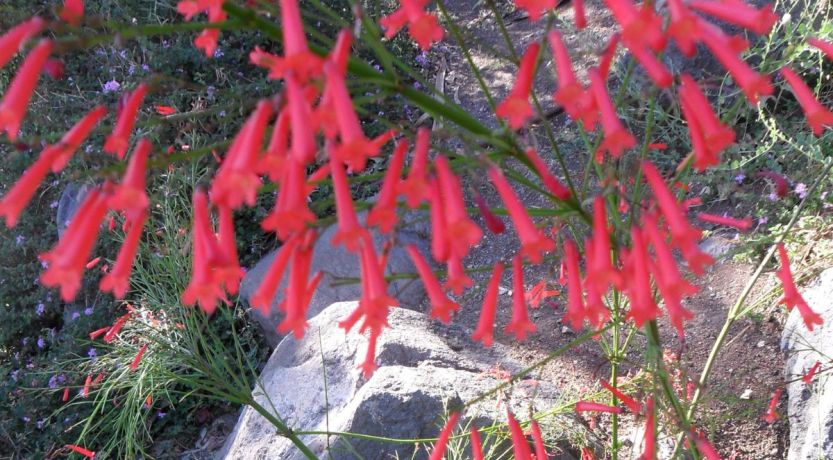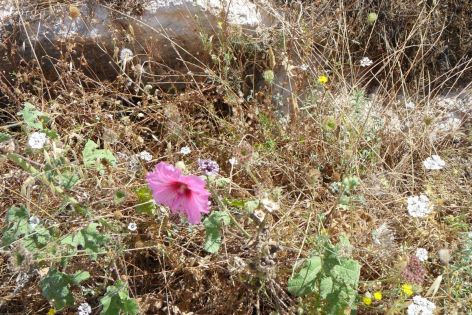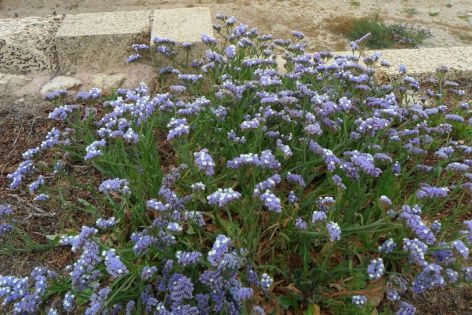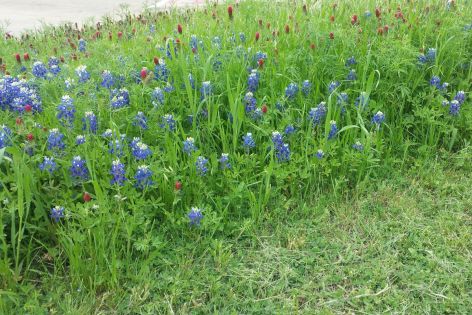The myriad wildflowers of the world are wonders of God’s creation. They are photogenic and can be thought-provoking. Why did Jesus tell us to consider them?

Wildflowers in Israel (photo by Becky Bennett).
The Grand Canyon, Niagara Falls, giant redwood trees—these majestic wonders of nature are well-known for producing a sense of awe. But does something have to be big to be wondrous? No. In the past few years, researchers have found that taking time to appreciate the everyday beauty of nature can also give life meaning.
Joshua Hicks and Frank Martela, authors of a 2022 study, found that people who had a strong appreciation for the common instances of beauty in the world around us were more likely to feel that their own existence was valuable.
Hicks and Martela gave this advice: “We should slow down, let life surprise us and embrace the significance in the everyday” (ScientificAmerican.com).
Scientists and psychologists have only recently begun to understand this. But long ago, Jesus knew that pausing to look at, appreciate and think about something as small as a wildflower can have a powerful impact on our lives.
“Consider the lilies” scripture
In His Sermon on the Mount, Jesus included the following instruction for His followers:
“Consider the lilies of the field, how they grow: they neither toil nor spin; and yet I say to you that even Solomon in all his glory was not arrayed like one of these” (Matthew 6:28-29).
The immediate context of these words of Jesus was about not worrying, especially not worrying about such physical needs as clothing. Jesus introduced the subject by saying, “Do not worry about your life, what you will eat or what you will drink; nor about your body, what you will put on. Is not life more than food and the body more than clothing?” (verse 25).
A thorough study of Matthew 6:25-34 and Jesus’ instruction not to worry can be found in our article “Do Not Worry About Your Life.”
“Even Solomon in all his glory”
What can we learn by considering—thinking about—the lilies of the field and how they grow?
What are the lilies of the field? Some have proposed specific flowers, such as various types of lilies, anemones, poppies, gladioli, amaryllis or daisies. Ellicott’s Commentary suggests that “all these are probably classed roughly together under the generic name of ‘lilies,’” and The Expositor’s Bible Commentary says that “lilies of the field” may be “any of the wild flowers so abundant in Galilee.”
More wildflowers in Israel (photo by Becky Bennett).
Flowers “of the field” are wildflowers that grow on their own. They aren’t intentionally planted or cared for by people. God created them and set in place the process that allows them to flourish without being tended by any human gardener. He causes the wildflowers to grow, providing them with the sunshine and rain or dew that they need.
Jesus said that “even Solomon in all his glory” was not dressed like one of these everyday beauties (verse 29)!
What was King Solomon’s clothing like? I can only imagine. But the queen of Sheba, who heard of Solomon’s fame and visited his kingdom, was impressed just to see what his servants wore (1 Kings 10:4-5).
If his servants’ uniforms were special and attractive, how much more beautiful would Solomon’s own apparel have been?
But Solomon’s extravagance couldn’t compete with God’s everyday beauty.
Intricacy and variety
If we pause, closely examine and consider a wildflower, we will find it very captivating.
We might notice its delicate petals. Petals come in a variety of shapes: the star-shaped day lily, the bowl-shaped buttercup, the trumpet-shaped morning glory, the urn-shaped heather, etc. Wildflowers can be divided into 17 groups based just on their shape.
Even more wildflowers in Israel (photo by Becky Bennett).
We might also observe a wildflower’s color. Some wildflowers are bright; others are more muted. And the color can change as the flower ages.
The comparison of Solomon’s clothing to the beauty of the lilies of the field becomes clearer the closer you look. As G. Campbell Morgan wrote, “Take the finest fabric that monarch ever wore and submit it to microscopic examination, and it is sackcloth. Take the lily and submit its garment of delicate velvet to microscopic examination and investigation, and the more perfect your lens the more exquisite the weaving of the robe of the lily will be seen to be” (The Gospel According to Matthew).
And, of course, we might stop and actually smell a flower—taking note of its fragrance. Different flowers produce different fragrances, of course. The fragrance is actually a combination of oils produced in the flower’s petals, designed to attract a particular type of pollinator. Scientists have identified 1,700 different scent compounds produced by flowers, and a flower can have many of these compounds. Some flower fragrances are brews of more than 100 compounds, according to Natalia Dudareva, a biochemist at Purdue University.
Thriving in hard conditions
Texas bluebonnets (photo by Becky Bennett).
I enjoy looking at a solitary wildflower, soldiering on by itself, but I’m also amazed when a particular variety has become so abundant it covers a field. Personally, I never tire of seeing the blankets of Texas bluebonnets (perhaps with some Indian paintbrush thrown in) along highways in the spring.
I’ve found it interesting to learn that wildflowers grow and even thrive in poor, dry and rocky soil. Unlike their cultivated cousins, they don’t need good topsoil, compost, fertilizing and regular watering. They’re perfectly designed for the natural conditions.
The reason for a flower
As we admire these natural beauties, we might also notice how they’re appreciated by other life-forms. Butterflies, bees and other pollinators enjoy what wildflowers offer. That’s part of the purpose of wildflowers. But they also need the pollinators. Without them, many wildflowers wouldn’t be able to produce the seeds for the next year’s crop. Wildflowers—like all of God’s creations—have a purpose.
Yes, without a doubt, God beautifully “clothes the grass of the field” with a variety of wildflowers! They might come and go quickly, Jesus said, but God still cares for them despite their passing nature.
With that in mind, Jesus rhetorically asked, “Will He not much more clothe you, O you of little faith?”
Yes, of course, He will!
Seven lessons from lilies
I would guess there are countless aspects of wildflowers that we could consider—and, as a result, countless lessons that we can learn from the lilies. Here are seven things I’ve been considering:
- God provides for us. It only makes sense to start with the lesson Jesus specifically referred to—that God will care for us even more than He cares for the flowers of the field. He doesn’t want us to worry. He wants us to trust Him to take care of us.
- God is a generous creator. The everyday beauty God has provided just in wildflowers is superfluous. We certainly don’t need all the beauty God has given us, but God is an abundant giver. He “is able to do exceedingly abundantly above all that we ask or think” (Ephesians 3:20).
- God is an amazing creator. Wildflowers with all their intricacy and design are only one of the many beautiful and wondrous things God has made. Like the stars in the sky, they “declare the glory of God” and show “His handiwork” (Psalm 19:1).
- God appreciates variety. He created all sorts of flowers—and the potential for even further variety—different colors, sizes, etc.—within each basic type. We’re told in 1 Corinthians 12 that God has intentionally put variety within His Church as well. Members are given different gifts and different roles and responsibilities.
- God wants us to grow even in difficult situations. Just as wildflowers can flourish even in harsh conditions, we can grow through trials and tribulation (James 1:2-3; Romans 5:3-5).
- God wants us to serve and give to others. Like the wildflowers that are visited by bees and other insects, we are to serve and share with others, and bear fruit—the fruit of the Spirit (Galatians 5:22-23). And just as the wildflowers benefit by sharing their nectar and pollen with others, so we can be blessed by having a generous, serving nature (Proverbs 11:25).
- God wants us to understand that this physical life is temporary and passing. Wildflowers’ time to blossom is often short. They’re here today and gone tomorrow. Flowers shrivel, beauty fades. Likewise, our beauty and youthful vigor fades as we age. But God has more in store for us. He wants us to develop His character and be His children—part of His family forever! See “What Is the Real Purpose of Life?” and learn more about the wonderful future we can have as part of God’s eternal family.
For your consideration
Wherever you live, when “the winter is past” and “the flowers appear on the earth” (Song of Solomon 2:11-12), take some time to admire the wonders of the wildflowers.
When you consider the lilies, what lessons will you learn?




